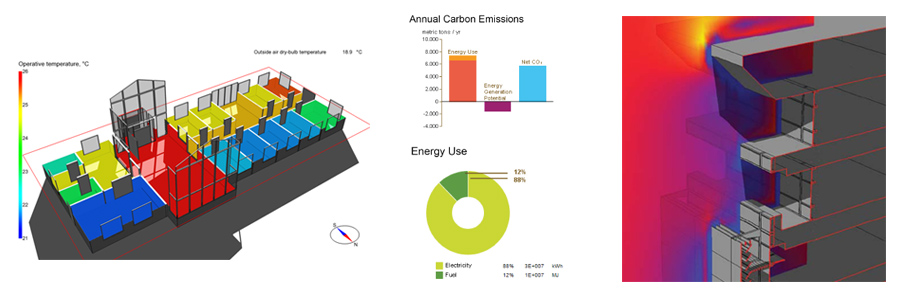Introduction
In a time with economic uncertainty at global level – and very specially in the building construction sector- with a growing interest in the care of our environment and in the improvement of energy efficiency in the built environment and in a time where it is necessary to optimize the means and resources, it is now when using tools that predict the future behavior of buildings becomes more imperative than ever.
The energy modelling is the process of creating a virtual representation or replica of a building – with its constructive-technical components and occupants- to be exposed by means of a computer software over a period of time – advisably a year- to different conditions and situations, both climatic and geographic, use and occupation, in order to obtain quantitative and qualitative results of its energy behavior.
Moreover, in our daily design and consulting work, to obtain a reliable energy simulation model is an effective and extremely useful tool, for reasons I will explain later.

When is it necessary? The ideal time is…
The ideal time to start working with virtual models of the building is in the initial period of the project. It is advisable during the conceptual design phase, because it is at this point where decisions have greater influence. In other words, decisions and actions that are performed at the beginning of the project will impact more positively throughout the life cycle of the project (Conception – Design – Construction – Occupation – Application – Final Life Cycle / Reuse).
To carry out energy simulation processes and implement changes in advanced stages of design are much more expensive and also cause a longer implementation. Unfortunately, due to lack of foresight, this is what usually happens in our professional field.
Implementation phases. The significance of the inputs.
Whatever the time of simulation is of utmost importance perform a correct data input insertion, since otherwise the results will lead to wrong conclusions. An energy simulation process of a typical building has the following main phases:
• 1. Model geometrically and define of climate and location conditions.
• 2. Define the architectural envelope and uses of the building.
• 3. Define the air-conditioning, hot water and lighting systems.
• 4. Run simulations and interpret results.
• 5. Redesign the project / proposal and restart the process / Finish.

What tool or software to use?
The answer to this question can be found in the combination of three variables: Project scope, time and resources. Depending on the importance assigned to each of them, we will get the solution. In other words, we have to choose our tool energy simulation depending on the scale and complexity of the project, the difficulty and labor hours required to enter input data, the project phase where we are, and what it is more important: the degree of precision sought in the final results (outputs) in order to obtain conclusions and apply them in the design.
If we wish to perform a quicker process, with fast simulation models it is possible to establish a clear basis to help us check and optimize our design and also to compare it with a baseline model. In this situation the use of a spreadsheet can be more than acceptable, and the utilization of sophisticated software tools that involve more time and resources wouldn’t be necessary.
Today the market offers us abundant – and even excessive- energy simulation software, either in the form of spreadsheets or more complex tools capable of analyzing not only the energy performance of the building, but also the Life Cycle Analysis (LCA), the daylight level of spaces, the economic feasibility or the calculation of natural ventilation also called CFD (Computational Fluid Dynamics), etc. In other words, the pieces are arranged. It depends on us how we want to play the game…
Benefit, utility, performance…
The great virtue of the energy simulation is undoubtedly to predict the future behavior of the building in a quantitative and qualitative way. And this has an evident and undeniable great value. This valuable information helps us to optimize our design in different ways: With relatively speed is possible to compare different options, for instance the related to passive design such as orientation and shape of the building, the facades composition, the percentage of fenestration, the building envelope, thermal transmittances (U value), among others, and also the ones associated to mechanical system design such as HVAC, hot water and lighting system, and this way to choose the most suitable, viable and sustainable solution.
In any architectural project is necessary to set clear and realistic goals for energy, environment, economy, and also check them in order to know if the proposal is viable. The economic analysis and amortization of the proposed solutions can be made before the construction phase. For some buildings in particular, the increase of the energy efficiency can reduce construction costs.
Summing up the process: Fast iterations, rapid feedback and better results.
Final words
The energy simulation is an important, effective and powerful tool in the global and integrative process that must have an architectural project, but it is also fair to say that is not the ultimate solution to all problems. There are no magic solutions derived from it, but its use can enhance synergies and improve the quality of the project.
Moreover, from our experience as criteria we advise not to rely on a single simulation tool to analyze a particular model, it is also necessary and advisable to compare values obtained from using different softwares.
The final and main purpose of using the energy simulation tool is to help increase energy efficiency of buildings and this must be achieved especially from the architecture using bio-climatic strategies for improving the passive design and reducing dependence on HVAC mechanical systems, moreover considering one important thing: we must remember that above all our mission as architects is to create high quality and comfortable spaces for its occupants.
Julio Bermejo arch.
Aa, February 2015
